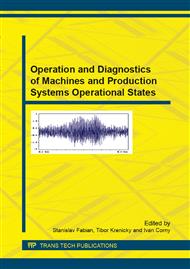[1]
Hošovský, A., Numerical approximation of static characteristic of PAM-based antagonistic actuator, In: Journal of Applied Science in Thermodynamics and Fluid Mechanics. Vol. 1, no. 1 (2007), Liberec, CR, 4 pp. - ISSN 1802-9388
Google Scholar
[2]
Boržíková, J., Piteľ, J., Tóthová, M., Šulc, B., Dynamic simulation model of PAM based antagonistic. In: ICCC 2011: proceedings of the 12th International Carpatian Control Conference: 25-28, May 2011, Velké Karlovice, Czech Republic. S.l.: IEEE, (2011), pp.32-35. ISBN 978-1-61284-359-9
DOI: 10.1109/carpathiancc.2011.5945809
Google Scholar
[3]
Novák-Marcinčin, J,. Biomechanisms, Elfa, Košice, Sk, 1993, ISBN 80-7099-218-2
Google Scholar
[4]
Piteľ, J. & Boržíková, J. Model of the Pneumatic Actuator Based on Artificial Muscles, Proceedings of XXII International Scientific Conference "Mathematical Methods in Technics and Technologies MMTT-22", May 25–28, 2009, Pskov, ISBN 978-5-91116-087-2, p.102 –104, PGPI, Pskov, RU
Google Scholar
[5]
Piteľ, J. et al., Artificial muscles actuator - I. Design no. 5992, MPT: B25J 13/06, 11. 2011, owner: TUKE, FVT, KMIK, Prešov, SK
Google Scholar
[6]
Piteľ, J. et al., Artificial muscles actuator – II. Patent application no. 42-2011, MPT: G01D 13/00, registration: 23. 05. 2011, owner: TUKE, FVT, KMIK, Prešov, SK
Google Scholar
[7]
Židek, K., Šeminský, J., Automated rehabilitation device based on artificial muscles. In: Annals of DAAAM for 2011 & Proceedings of the 22nd International DAAAM, Symposium on "Intelligent Manufacturing & Automation: Power of Knowledge and Creativity": (2011), Vienna, Austria, pp.1113-1114.
DOI: 10.2507/22nd.daaam.proceedings.542
Google Scholar
[8]
Daerden, F. – Lefeber, D., Pneumatic Artificial Muscles: actuators for robotics and automation, European Journal of Mechanical and Environmental Engineering, Volume 47(1), 2002, pp.10-21, internet: <http://lucy.vuc.ac.be/publications/Daerden_Lefeber_EJMEE.pdf>
DOI: 10.1109/aim.2001.936758
Google Scholar
[9]
Dillmann, R. et al., FLUMUT – Dynamic Modeling of Fluidic Muscles using Quick-Release, 3rd International Symposium on Adaptive Motion in Animals and Machines, September 2005, Ilmenau, Germany, internet: http://www.fzi.de/KCMS/kcms_file.php?action=link&id=573
Google Scholar
[10]
Davis, S., Caldwell, G., Darwin, F., Braid Effects on Contractile Range and Friction Modelling in Pneumatic Muscle Actuators, International Journal of Robotics Research, Volume 25, Issue 4 2006, pp.359-369, internet: <http://www.robotcub.org/misc/review2/06_Davis_Caldwell.pdf>
DOI: 10.1177/0278364906063227
Google Scholar
[11]
Sárosi, J., Investigation of Positioning of Fluid Muscle Actuator under Variable Temperature, Acta Technica Corviniensis – Bulletin of Engineering, Tome IV, Volume 3, July 2011, ISSN 2067-3809, Hunedoara, Romania, pp.105-107
Google Scholar
[12]
Sárosi, J., Gyeviki, J., Véha, A., Toman, P., Accurate Position Control of PAM in LabVIEW Environment, IEEE, 7th International Symposium of Intelligent Systems and Informatics, Subotica, Serbia, 25-26 September, 2009, pp.301-305
DOI: 10.1109/sisy.2009.5291145
Google Scholar


